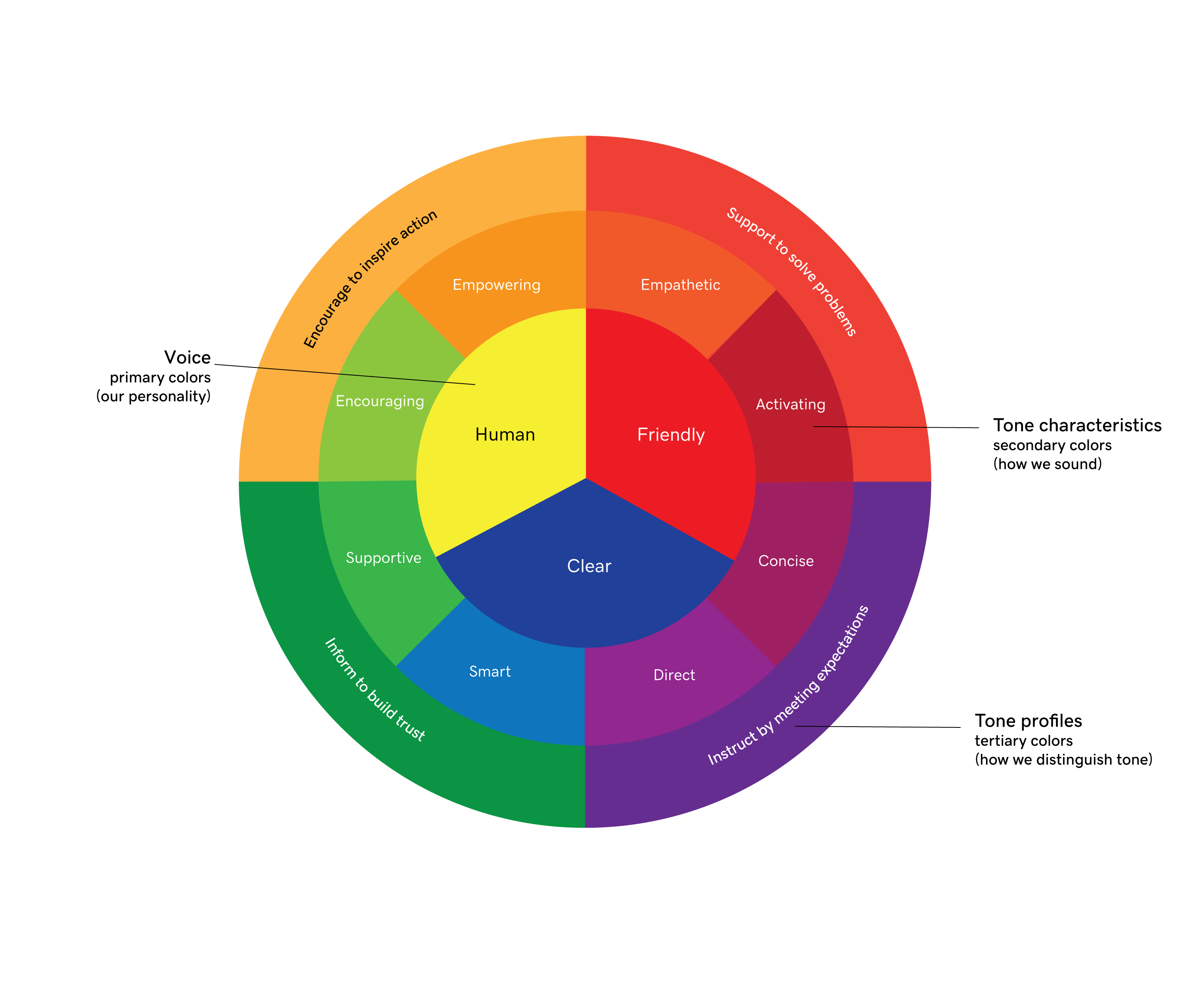GoDaddy Voice & Tone
Redefine the Help Center voice and tone principles
Role
Writer / Initiative lead
Contributing partners
Help Center writers, GoDaddy content teams (Brand Writing, Conversation Design, Customer Education, UX Writing, Email Design), Customer support, Customer Research
Timeframe
Jan - Dec 2022
Tools
Confluence, Contentful, Jira, Miro, Microsoft Office, UserTesting.com
Problem
The voice of the Help Center was inconsistent across content. Our voice and tone principles were outdated and we didn't have a method or cadence for auditing articles. There was a disconnect in the voice across GoDaddy channels, like our chatbot, videos, etc., and we didn't have a way of predicting or understanding how changes in tone affected our customers.
Solution
Define our voice in alignment with the GoDaddy personality and identify how our tone may change across Help content based on the customer's emotional state. Refine based on customer feedback via user testing. Align with other content teams by establishing a cadence and method of communication.
Value proposition
If we use tone with intention, we can build trust and authentic relationships with our customers through all their interactions with GoDaddy. We'll also build the integrity and lifespan of our content by developing processes for implementing and maintaining our voice.

Initial timeline for voice and tone intiative
Stage 1: Research
I hosted two kickoff meetings with seperate goals in mind:
- Stakeholders from six GoDaddy content teams: Understand the current state and use of voice and tone across GoDaddy. Join forces with other teams by establishing a regular cadence of communication and aligning efforts.
- Help Center writers: Share the plan for the initiative, and discuss how writers currently think about voice and tone in their content.
Stage 2: Define
Next, I defined our voice and built a framework for how our tone may flex across Help content.
- Our voice: In alignment with the GoDaddy brand, our voice is human, friendly, and clear.
- How our tone may change: Based on the customer's emotional state, our tone will align with one of four tone profiles ("Encourage to inspire action," "Inform to build trust," "Instruct by meeting expectations," "Support to solve problems"), defined by key characteristics, the customer's emotional state, and applicable content types.

Voice and tone principles represented in a color wheel
Stage 3: Test
I established a methodology for testing and validating our tone using our onboarding content type:
- Identify the appropriate tone profile for a specific content type.
- Audit the tone of existing articles.
- Choose three articles to test.
- Rewrite the articles in alignment with the defined tone, or leave them as-is.
- Run a series of user tests to validate the tone.
- If the tone's validated, document the best practices using a "think this, not that" format and add them to our team's guidance in Confluence.
The user test took several iterations in collaboration with the Customer Research team to refine and eventually consisted of 5 verbal and 7 rating-scale questions. We targeted specific GoDaddy customers based on the article content and associated products.
We measured the impact of tone based on two factors: (1) if the customer's interpretation of the tone matched our intended tone, and (2) if the tone affected the customer's sentiment towards GoDaddy. The tone was considered validated if there was an overall positive sentiment and if the tone was identified as intended.
Stage 4: Implement
Workshops: To help writers get used to writing with tone in mind, I hosted a workshop. I set the stage by explaining the tone profile and the best practices, and then break the team into smaller groups. In their groups, they'd workshop one of the writer's articles through the lens of tone. We'd come back together as a team and then share what we found.
Governance: I documented and shared a system of governance, encouraging the team to follow a research, discussion and implementation process to revise the voice and tone principles.
Syncs: Although the voice and tone work was completed, I planned to continue hosting quarterly syncs with the other content teams as way to maintain awareness of other customer-focused efforts.
Impact and results
Through the voice and tone initiative, I:
- Established communication across the 7 content teams at GoDaddy (Slack channel, quarterly meetings, and general awareness of who owns what across the company)
- Defined the Help Center's voice and its 4 main tone variations, which will be used by its 12 writers in thousands of our articles
- Concluded that the changes to our voice and tone contribute to increased positive sentiment toward GoDaddy
- Developed a 6-step methodology for auditing the tone of Help Center content and for integrating the tone through the authoring workflow
Reflection
This intiative challenged me by forcing me to return to the foundations of why I'm passionate about what I do: "How do we help customers solve their problems?" It all comes down to the language - but that language changes based on context, and the context at GoDaddy was shaped by the customer's emotional state, their journey with the product, and their previous experience with us (Did they talk to a customer support agent? Did they get an email from us?). As a team, we had to first understand all the touchpoints that a customer might encounter and then build bridges between them. We had to make our voice consistent, but still distinguishable depending on when we interacted with the customer.
I'm so grateful for each team's openness to innovation, and for supporting me as I led this initiative. Projects like this are only ever successful if everyone is on board, so it wouldn't be possible without each team's support.
